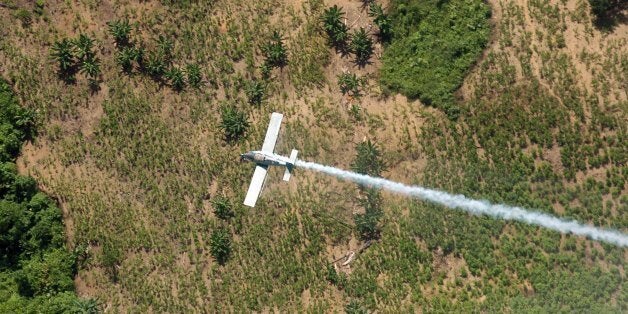
Yesterday, the Colombian government ended the decade-long aerial spraying program to eradicate illicit crop cultivation. This came after the recent release of a study by the International Agency for Research on Cancer(IARC), a research arm of the World Health Organization, which found that the main chemical used in the aerial spraying program, glyphosate, is likely carcinogenic to humans.
After the report was released, Colombian Health Minister Alejandro Gaviria made a strong recommendation to cease aerial spraying, stating that the report's findings on glyphosate represent an "inescapable warning of possible adverse health effects." Colombian President Juan Manuel Santos responded by saying, "I am going to ask the government officials in the National Drug Council at their next meeting to suspend glyphosate spraying of illicit cultivation [of coca]". This decision was taken yesterday during a meeting with the National Council on Drugs, in which the Ministries of Health, Justice, Interior, and the offices of the Inspector General, Prosecutor General and Ombudsman were present.
The health risks of glyphosate have long been of concern to Colombian academics, non-governmental organizations, and communities affected by spraying. But the burden of proof of harm has rested mainly with the affected communities, who have long complained of skin rashes, irritations and genetic abnormalities resulting from this practice.
The damaging effects of glyphosate are compounded by the vast amounts necessary to eliminate crops. A recent study by Pascual Restrepo of MIT and Sandra Rozo of UCLA showed that for every hectare sprayed with glyphosate, illicit crops are reduced in only 0.035 hectares. In other words, to eliminate a hectare of coca, 30 hectares must be sprayed with glyphosate, at a financial cost of $72,000 per hectare. This is an inefficient program, which affects the country's health and environment. In 2007, Afghanistan halted the use of glyphosate for aerial spraying, leaving Colombia the only country in the world to continue with this practice, until yesterday.
It's good to see scientific evidence emerging to support the claims that Colombian communities and indigenous groups have long been making about the health and environmental harms of fumigation. But the problem of forced crop eradication goes beyond this single herbicide. A program based on forcing farmers to eradicate their crops – whether aerially or manually – in the hope that it will reduce overall drug supply is neither realistic nor ethical. Increased eradication has often produced the "balloon effect" of simply displacing cultivation elsewhere, without reducing the overall availability of, or market for, illicit drugs.
Colombia should use this opportunity to take the conversation beyond glyphosate and call into question its overall approach to drug cultivation and drug policy. Instead of forcing the eradication of an abundant and ancestrally-used crop, Colombia should focus on development programs, licit production of the coca leaf for commercial and ancestral uses, and shift its efforts from repression to health and development.
Hannah Hetzer is policy manager of the Americas at the Drug Policy Alliance.
This piece first appeared on the Drug Policy Alliance Bloghttp://www.drugpolicy.org/blog/colombian-president-calls-suspension-aerial-spraying-illicit-crops
